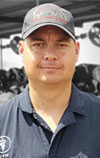Proper corral management is necessary to provide cows these things:
- A clean environment that will help reduce disease risk (i.e., mastitis, lameness, etc.)
- A comfortable environment to encourage the cow to increase resting time (Resting time is directly associated with increased milk production.)
- Increased cow comfort that can reduce the risk of lameness and injury
- Minimize the energy requirement demanded from walking through deep mud
The following 10 protocols can help in achieving these objectives for comfortable, healthy and productive cows.
1. Stanchion slab
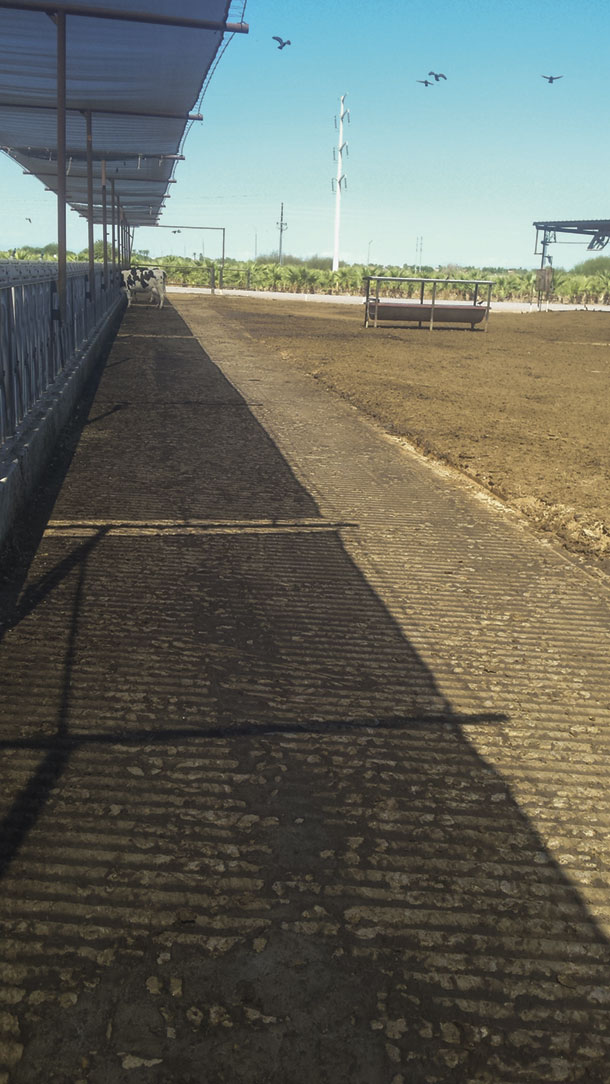
The stanchion slab must be scraped, flushed or vacuumed at least once daily. Maintaining clean slabs is important to reduce the risk of injury and disease. Flushing and vacuuming removes wet manure from the stanchion slab, helping to avoid overburdening the pen space with wet manure buildup, especially during cooler, wetter periods. Flushing multiple times per day permits easier cleaning function by the flush system. Vacuuming is best done with more wet manure, so it may not be available during hot and dry periods.
The area behind the slab must also be clean and free from buildup of manure. When this area gets extremely wet, holes and drop-offs begin to form, which create injury risks and make it difficult for the cows to enter and exit the feed slab.
2. Fencelines/travel lanes
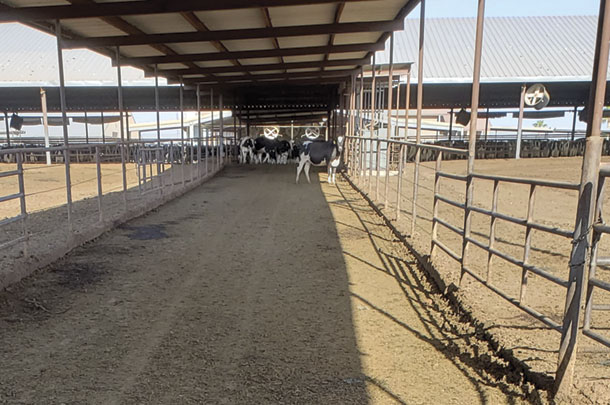 Fencelines should be maintained clean and free from manure buildup. This creates a path for excess moisture to drain out of the corral and helps to prevent rusting and damage to the fenceposts. One tractor width of clearage is adequate along all fencelines. Ensure the corral exit travel lanes are also clear from manure buildup. Cows should have a clear exit path out of the corral to the parlor and back. This will help the process of moving cows to the parlor and minimize the loss of energy walking through deep manure buildup.
Fencelines should be maintained clean and free from manure buildup. This creates a path for excess moisture to drain out of the corral and helps to prevent rusting and damage to the fenceposts. One tractor width of clearage is adequate along all fencelines. Ensure the corral exit travel lanes are also clear from manure buildup. Cows should have a clear exit path out of the corral to the parlor and back. This will help the process of moving cows to the parlor and minimize the loss of energy walking through deep manure buildup.
Routinely inspect fencelines, gates and stanchions for broken pieces that may cause injury to cows. This could be broken cables, loose or broken fenceposts, hanging gates, etc. It is important to correct the problems immediately.
3. Water troughs
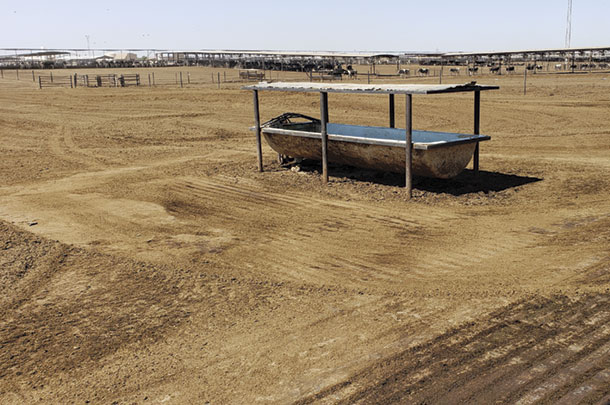
Areas around water troughs should be maintained clean and free from manure buildup at all times. Cows accumulate around water troughs and will create adverse ground conditions if not maintained properly. Since water is a vital nutrient, it is important to provide easy access at all times. Areas around water troughs should be prepared with a cement slab to prevent the formation of holes or uneven ground.
4. Barn walkways/travel lanes
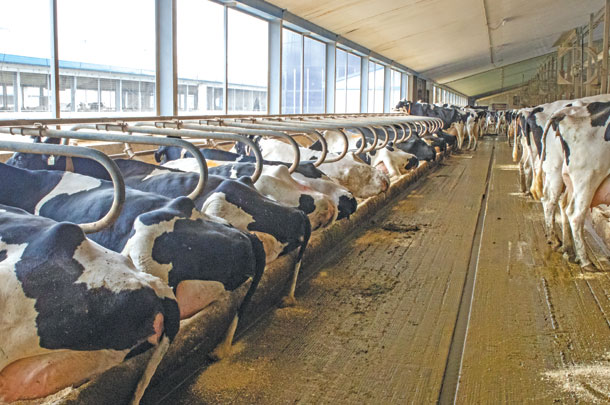
Cement walkways in barns and other areas should always be free from excessive manure buildup. Excessive manure can make walking slippery and difficult. Walkways should also be grooved to provide traction for the cows’ feet. Current recommendations are for grooves to be a half-inch deep, half to three-quarters of an inch wide, spaced 3.25 inches apart, with vertical edges (according to the Dairyland Initiative). Proper grooving can help prevent cows from slipping or falling.
Travel lanes should also be scraped routinely to prevent buildup of manure that can impede flow, create slippery situations or other problems. Always monitor travel lanes for problems that need to be fixed: holes in the cement, lack of traction/grooving, foreign debris that may cause injuries. Slopes and steps may make travel difficult and create traffic flow issues or potential for injury if good footing does not exist.
5. Open lots
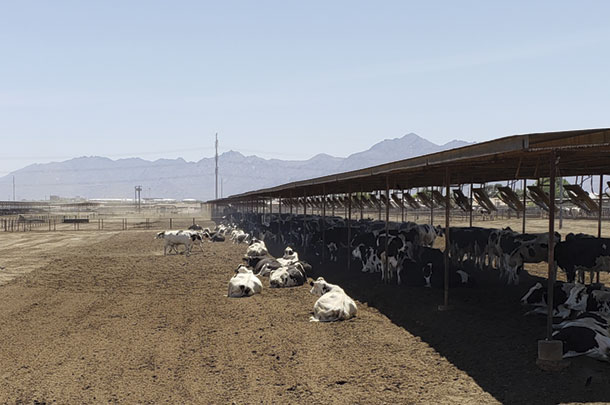
Shades should be managed to always have 4 to 6 inches of dry, soft bedding. This typically requires wet manure to be scraped out daily and fresh, dry manure to be brought in to maintain a deep-bed pack. Treat the areas immediately to the side of the shades the same. As the sun moves, the shaded area shifts and will switch sides from morning to afternoon. In the heat, cows prefer shaded areas over bedded areas, so ensure there is good bedding where the cows want to lie.
In cooler weather, cows will disperse throughout the corral, so it is important to create dry, soft bed packs away from the shades to allow the cows to spread out and have comfortable resting areas. Again, make sure the bed packs are 4 to 6 inches of dry, soft bedding.
Utilize the extra space in the corral for spreading and drying of wet manure. It is important to spread the manure thin to allow for drying. Also, a harrow or rototiller should be used to mix the wet manure, continually exposing more surface area to dry. Once dry, this can be used to refill the bed areas or stored for future use. Differentiate areas in the open corral to be used for drying and storing manure.
6. Freestalls
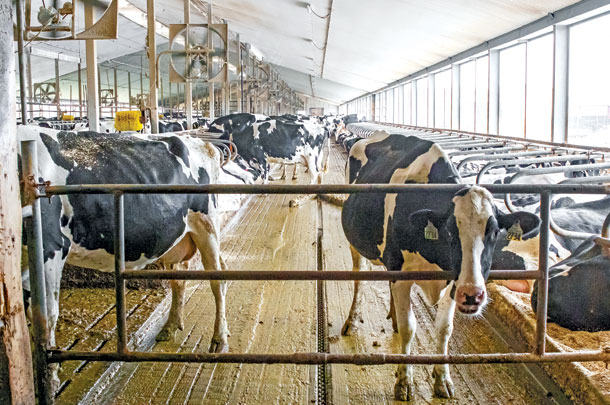
Freestalls create a great opportunity to maintain an ideal bed pack for cow comfort, without threats from adverse weather. Typically, precipitation is not an issue with covered freestall barns. Stalls should be maintained with 4 to 6 inches of dry, soft bedding – whether sand or manure solids. Mattresses can also be used to provide a soft, comfortable bed. Prevent piling or sloping of the bed pack that hinders the cow from lying naturally and comfortably. Make sure the stalls have a flat surface across the back curb to the front brisket area. Sunken beds should be refilled more frequently.
Oftentimes, the top surface of freestalls appears to be soft but not deep. Rakes may not penetrate deep enough to create the 4 to 6 inches of optimal bedding depth. The use of a side-rototiller may help fluff deeper stall depth.
7. Measure bedding depth
It is important to monitor and evaluate bedding depth for maximal comfort. The “knee drop down” test has been commented on in the past, but since cows are much heavier animals, I prefer a more metric system of evaluation. Currently, 4 to 6 inches is the recommended bedding depth. This can be measured with a simple ruler and can provide valuable feedback. It is important to make sure new dry bedding is not spread on top of wet manure; the wet manure should be removed before new bedding is applied.
8. Drying manure for bedding in the corral
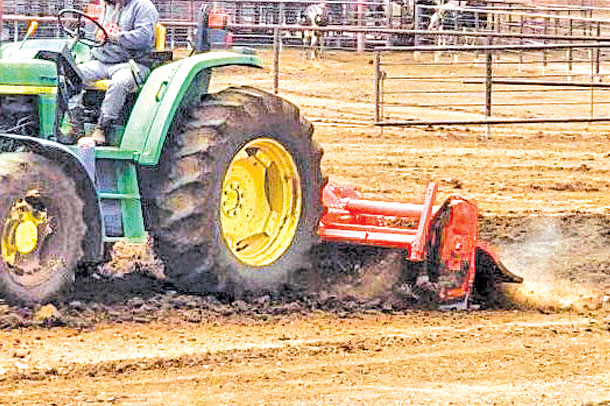
Utilize the full space of the corral to dry manure for bedding. Spread the manure thinly to expose the surface area to the sun. Drag with a harrow or tiller to turn over the bedding, thus increasing the surface area exposure to the sun. Rototillers can be used in deeper sections to thoroughly break up and mix bedding to create softer, drier bedding.
9. Accumulate bedding
It is important to accumulate an excess of dry bedding to be used in times of bad weather. Having a supply of dry bedding is imperative to properly maintain corral bedding conditions at all times. The ability to remove wet manure and replace with dry bedding can help minimize the impacts to udder and hoof health. When the corrals have an excess of wet manure, it is important to be able to haul out the wet and resupply with dry bedding.
It is best to have a surplus of dry bedding that can be accessed and used to re-bed wet corrals during poor weather. This surplus pile can be maintained inside or outside the corrals. Typically, long-term storage is done outside the corrals that can be hauled back in as wet manure is hauled out for drying purposes. Short-term storage of manure can be done with smaller piles maintained in the corrals.
10. Prepare corrals for wet weather
Have a plan in place to prepare for wet weather. Bed shaded areas with extra dry bedding (6 to 10 inches) to account for a potential delay in access to get in the corrals after the storm, if the corrals are too wet. Scrape all manure from the pen into large, high piles (minimizes top surface area that is exposed to rain) that will allow for water run-off. Clear the sloped water drainage areas so the water is not absorbed by the manure in the corral. It is also important to clear drainage ways from manure buildup to enable the rainwater to flow out of the corral.
There are many areas on the dairy that need routine maintenance, including the bedding and walking areas. Standard protocols with direct objective goals help to ensure consistent success on your dairy. Using these guidelines to develop farm-specific corral maintenance protocols can help maximize cow comfort and reduce the risk of disease. ![]()
PHOTOS: Courtesy photos.

-
Douglas A. Prante
- Veterinarian
- Dairy Veterinary Services
- Email Douglas A. Prante
